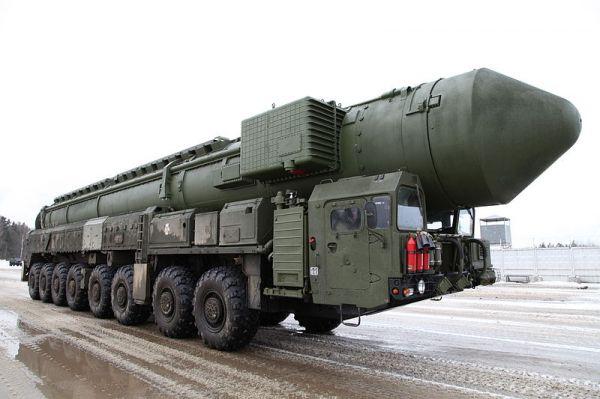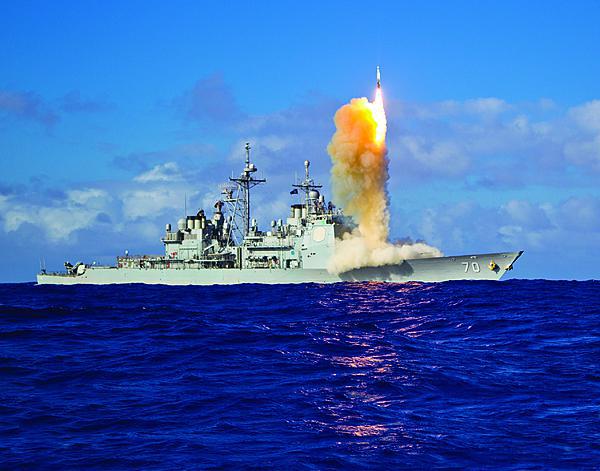U.S. Missile Defense Lags Emerging Threats
The U.S. missile defense program now trails emerging ballistic missile threats from rival nations that are outspending the United States in quests to move ahead and stay ahead, defense analysts caution. Emerging technologies such as maneuverable re-entry vehicles, a type of ballistic missile warhead capable of shifting course in flight, essentially render existing U.S. antiballistic missile defense capabilities ineffective.
Dealing with these advanced ballistic missile technologies could require a major revamping of the U.S. missile defense effort. Currently, while nations such as Russia and China have capabilities to circumvent current U.S. defenses, it is the less sophisticated “rogue” states of North Korea and Iran that continue to amass world leaders’ focus—and billions of dollars—on missile defense.
“China and Russia, traditional competitors of the United States, continue to expand the range and sophistication of their strategic arsenals at a time when the United States debates deep reductions in its strategic nuclear forces beyond those already made since the end of the Cold War and has no current modernization program,” reads a portion of a 2009 report by the Independent Working Group (IWG) for the Institute for Foreign Policy Analysis. “The number and sophistication of these threats are evolving at a pace that no longer allows the luxury of long lead times for the development and deployment of defenses,” the report notes.
The situation has not changed in five years. The sophistication of new maneuverable re-entry vehicles (MARVs) would require missile defenses that can strike attacking missiles during the boost phase of a ballistic flight. Overall, the U.S. missile defense program is behind the emerging threat, both from declared foes of the state and even one-time friends, says Michaela Dodge, policy analyst for defense and strategic policy at the Heritage Foundation.
“Currently our missile defense systems are not built to deal with ballistic missiles from China or Russia,” Dodge says. “They’re built to address the less sophisticated ballistic missile threat from North Korea.”
Russia has increased its reliance on nuclear weapons in its most recent national security strategy. China’s nuclear weapons strategy remains opaque and extensive nuclear modernization programs are underway, avows the Heritage Foundation. And yet the United States has not officially labeled either as a threat.
Officials from the U.S. Missile Defense Agency (MDA) declined to be interviewed, but spokesman Richard Lehner issued a statement that reads, in part, “I won’t get into specific technology efforts, but we are continually developing the scientific and engineering capabilities to meet the type of ballistic missile threats we may expect from countries like North Korea or Iran.”
Addressing the fact that neither North Korea nor Iran have MARV capabilities, Lehner replies in the statement: “U.S. missile defense systems pose no threat to the missiles of the Russian and Chinese deterrent force.”
And it would seem U.S. officials have not been reserved in hiding the defense system’s Achilles’ heel. “It is not our intent, and it would be far too expensive, and far too destabilizing, to try to build a system to defend against the large and sophisticated arsenals of Russia or China,” said Madelyn Creedon, assistant secretary of defense for Global Strategic Affairs, to Russian counterparts during a meeting in Moscow in May 2013.
“[U.S. systems] require a threat missile to achieve burnout before we can calculate a firing solution,” Creedon explains, according to a meeting read out. “Why? Because before burnout, the threat missile continues to accelerate, and continues to adjust its direction. It is only after burnout that the threat missile is on a ballistic trajectory, and it needs to be on a ballistic trajectory for any ballistic missile defense system to calculate an intercept solution for an incoming threat missile.”
Russia has more than 1,400 nuclear warheads deployed on long-range ballistic missiles that can reach the United States within 33 minutes. “Currently, our nuclear doctrine says that Russia is our friend and the potential for conflict is very low,” Dodge says. “Well, it is not low if you are considering [Russian President Vladimir] Putin may not be deterred from attacking the Baltics or other members of NATO, or if you consider that Putin said the [the collapse of the Soviet Union] was the largest geopolitical catastrophe of the 20th century.”
“Given Russia’s demonstrated willingness to use force to alter nations’ boundaries and act against U.S. interests, it is clear that the U.S. should expand its ballistic missile defense to protect itself and its allies from Russia’s ballistic missiles,” Dodge wrote in a March issue brief following Russia’ annexation of Crimea this spring.
Former Defense Secretary Robert Gates, in a March 26 piece published in The Wall Street Journal, wrote, “Mr. Putin aspires to restore Russia’s global power and influence and to bring the now-independent states that were once part of the Soviet Union back into Moscow’s orbit. … There is no grand plan or strategy to do this, just opportunistic and ruthless aspiration. And patience. Mr. Putin … is playing a long game.”
It would take a concerted effort to launch a credible ballistic missile defense (BMD) program to counter emerging threats such as MARVs. Space-based defenses would be a start, some experts say.
“In the 21st century, space has replaced the seas as the ultimate frontier for commerce, technology, and national security,” reads the IWG’s writeup. “Space-based missile defense affords maximum opportunities for interception in boost phase before rocket boosters have released warheads and decoys or penetration aids.”
Dodge says she would bring back Brilliant Pebbles, which had been part of the Strategic Defense Initiative proposed by former President Ronald Reagan. Brilliant Pebbles was a non-nuclear system of satellite-based interceptors designed to use high-velocity projectiles. The defense system received a nod of approval from the IWG’s assessment of the nation’s missile defense.
“Although the Brilliant Pebbles program was terminated in the early 1990s, advances in the commercial, civil and other defense sectors since that time would now permit even lighter mass, lower cost and higher performance than would have been achieved by the 1990-era technology base,” reads the IWG’s report, titled “Missile Defense, the Space Relationship and the Twenty-First Century.” A cost estimate in 2008 for Brilliant Pebbles tallied $19.05 billion.
But more satellites would crowd an already overcrowded area in space hundreds of kilometers above the Earth, counters Brian Weeden, a former Air Force officer who worked in space and intercontinental ballistic missile operations and now is a technical adviser for Secure World Foundation, a private foundation dedicated to the secure and sustainable use of space.
“Space traffic management becomes a problem, debris becomes a problem, collision becomes a problem,” Weeden says. “If they are below the [International] Space Station altitude [of about 250 kilometers above Earth’s surface], [they are] not really a threat to anything else, but they’re not going to stay up there very long. If above about 600 kilometers to 1,000 kilometers, that’s the most congested portion of Earth’s orbit.
“It’s simply infeasible,” Weeden adds, saying adequate space defense would need hundreds if not thousands of additional satellites launched into the already congested areas hosting upwards of 1,200 active satellites. “They would probably be more of a threat to other satellites than have opportunity to shoot down ballistic missiles,” he says.
The MDA has requested Congress provide nearly $7.5 billion in fiscal 2015. None of the requested funding is for space-based systems. Instead, the funding will buy, in part, Long Range Discrimination Radar, a midcourse tracking radar that will provide persistent sensor coverage and improve discrimination capabilities against threats to the homeland from the Pacific, officials say.
The funding also will go toward the European Missile Adaptive Approach (EMAA), enhancing the deployed Aegis BMD ships at or heading for the Mediterranean Sea, a land-based radar in Turkey, and a command, control, battle management and communications (C2BMC) system node at Ramstein Air Base in Germany. Phases two and three of EMAA include additional Aegis BMD ships along with Aegis Ashore in Romania in 2015 and in Poland in 2018. Aegis Ashore will be able to launch Standard Missile-3 (SM-3) Block IA, IB and IIA variants.
The MDA will continue to increase homeland defenses to 44 ground based interceptors in Alaska and California. It will deploy a second forward-based X-band AN/TPY-2 radar in Japan and build and improve the C2BMC infrastructure at fielded sites and procure interceptors for Terminal High Altitude Area Defense (THAAD).
“The missile defense mission is becoming more challenging as potential adversaries incorporate BMD countermeasures,” MDA Director Vice Adm. James D. Syring, USN, said in testimony April 2 before the Senate Armed Services Committee’s Strategic Forces Subcommittee.
“Space-launch activities in Iran and North Korea involve multistage systems that serve to further the development of ballistic missile technology for longer-range systems, including intercontinental ballistic missile (ICBM)-applicable technologies and systems.” Iran could develop and test an ICBM by as early as next year, Adm. Syring testified.
Yet, the investment in missile defense science and technology dropped from roughly $350 million in fiscal 2014 to $176 million in fiscal 2015.
And China “has prioritized land-based ballistic and cruise missile programs to extend their strike warfare capabilities farther from its borders,” stated Alan Shaffer, acting assistant secretary of defense for Research and Engineering, in testimony March 26 before the House Armed Services Committee subcommittee on Intelligence, Emerging Threats and Capabilities. “Chinese military analysts have concluded that logistics and power projection are potential vulnerabilities in modern warfare, given the requirements for precision in coordinating transportation, communications, and logistics networks,” Shaffer testified, noting, “[The Chinese] are also developing a longer-range missile that would be able to strike as far as Guam. These ballistic missiles are coupled with advanced cruise missiles that could threaten any surface warfare fleet by 2020.”
Given today’s tense state of political affairs, officials soon might face a decision point on whether the United States should reassess its current missile defense plan. At the least, they might opt to boost funding for research and development for countermeasures that could address a vast collection of threats. Even if Russia and China are not the imminent threats, as is U.S. political posture, it might be just a matter of time before the rogue states of North Korea and Iran develop attack technology that outpaces U.S. defenses.






Comments